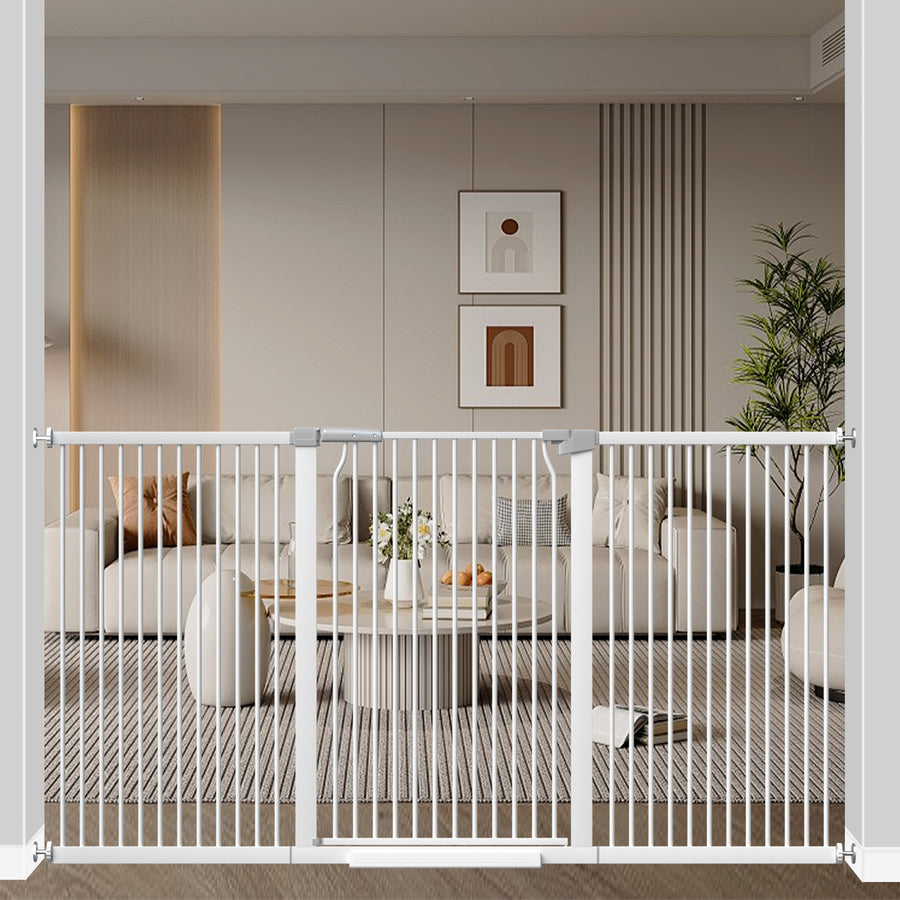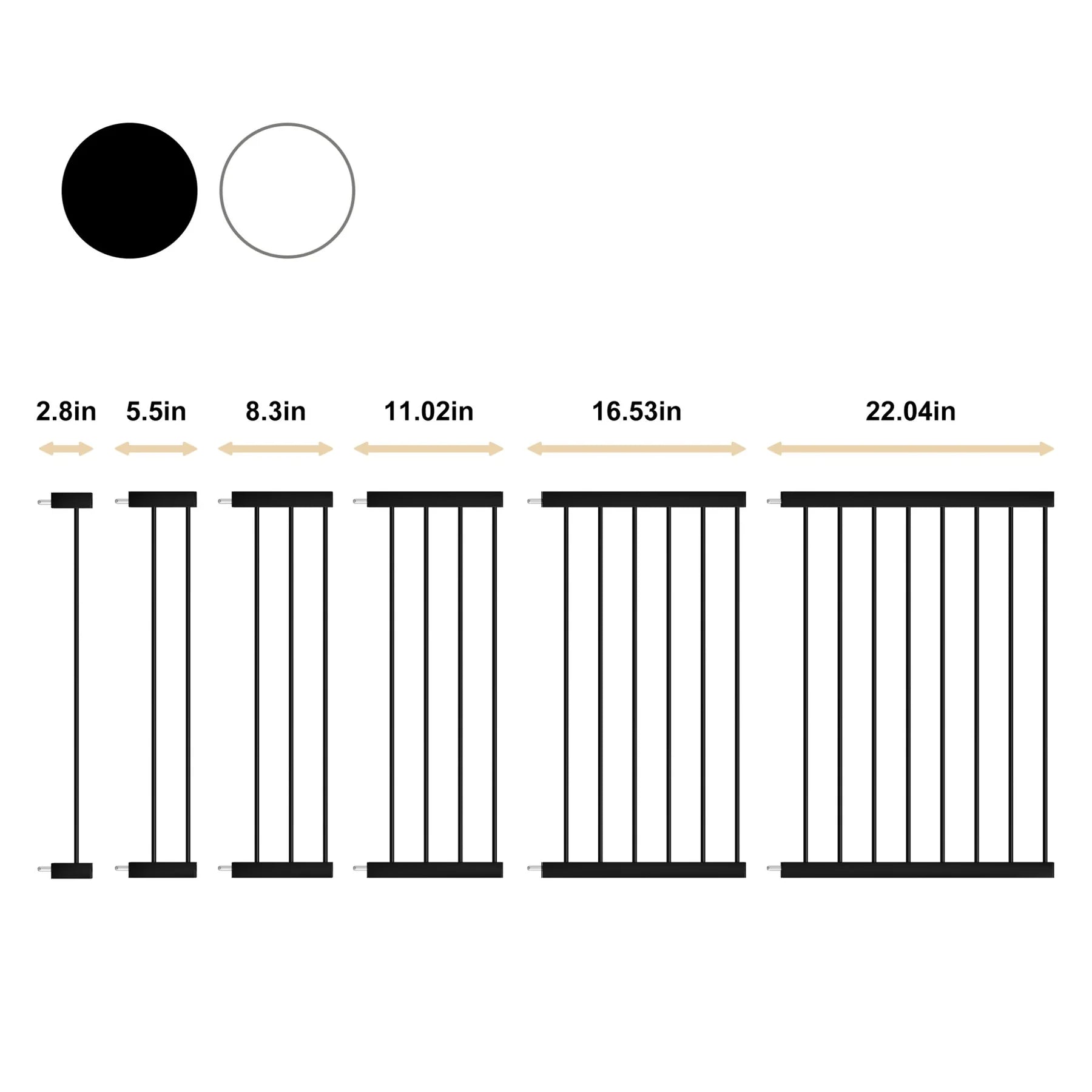Find the Best Baby Gates: Pressure vs Hardware vs Extra Tall in 2023!
As a parent, one of your top priorities is ensuring your child's safety. When they start crawling and walking, it's crucial to have proper baby gates installed to keep them away from potential hazards.
In this article, we'll compare the three main types of baby gates - pressure-mounted, hardware-mounted, and extra tall gates - on key factors like installation, durability, portability, and cost. We'll provide pros and cons for each type to help you choose the right gate for your needs in 2023 June.
Quick Comparison
| Type of Gate | Pros | Cons | For Age |
|---|---|---|---|
| Pressure-Mounted |
|
|
Under 18 months |
| Hardware-Mounted |
|
|
18 months to 3 years old |
| Extra Tall |
|
|
2 years and older |
Pressure-Mounted Gates
Pressure-mounted baby gates are a popular, budget-friendly option for childproofing homes. They rely on tension to brace securely in doorways and openings without the need for hardware. Pressure-mounted gates are easy to install and remove, making them ideal for rentals, temporary blockages or homes where drilling is not possible.
However, their lightweight design means they may not deter some toddlers from pushing them over or knocking them out of place. For basic containment on a budget, though, pressure gates can get the job done. Check the pros and cons of this gate below:
Pros
- Easy to install and remove: Pressure-mounted gates don't require any drilling or hardware, making them a great option for renters or temporary situations. They're designed to be held in place by pressure between the walls, so there's no damage to your walls or doorways.
- Portable: Since they're easy to install and remove, pressure-mounted gates can be moved to different openings in your home as needed. This can be particularly helpful if you have multiple areas you want to block off for your child.
- Typically cheaper: In general, pressure-mounted gates tend to be more affordable than hardware-mounted or extra tall gates, making them a budget-friendly option for many parents.
Cons
- Not as durable and stable: Because they rely on pressure to stay in place, pressure-mounted gates may not be as sturdy as hardware-mounted gates. Some toddlers may be able to push or knock them over, which can pose a safety risk.
- Not good for wide or angled openings: Pressure-mounted gates are limited to straight openings and may not work well for wide, angled, or uneven spaces.
- Have to be reinstalled every time you want to open and close the gate: Opening a pressure-mounted gate usually means taking it down and reinstalling it, which can be annoying and time-consuming.
Hardware-Mounted Gates
For the most robust and permanent childproofing, hardware-mounted baby gates are an excellent choice. These gates bolt directly into wall studs for maximum security and durability. Hardware-mounted gates can withstand repeated impact and pushing from kids without budging an inch. They also adapt to fit angled, wide or uneven openings. However, the secure installation requires drilling into walls, which means they typically cannot be used in rentals.
Hardware-mounted gates also tend to be the most expensive type, both due to materials and potential installation fees. But for long-term, heavy-duty childproofing, the investment in hardware gates is worth the peace of mind. Check the pros and cons below:
Pros
- Very sturdy and secure: Hardware-mounted gates are attached to the walls or doorways with screws, making them extremely stable and secure. It's difficult for children to push or knock them over, providing a safer environment for your little ones.
- Can be used for wide, angled, and uneven openings: Unlike pressure-mounted gates, hardware-mounted gates can be installed in a variety of spaces, including wide, angled, and uneven openings.
- Once installed, you just swing the gate open and closed: Unlike pressure-mounted gates, hardware-mounted gates typically have a door that swings open and closed, making it easy and convenient to use.
Cons
- Requires drilling into walls: Installing a hardware-mounted gate requires drilling holes into your walls or doorways, which can cause damage and may not be suitable for renters or those who want to avoid damaging their walls.
- Not portable: Because they're attached to the walls, hardware-mounted gates are not easily moved or reinstalled in different locations.
- Typically more expensive: Hardware-mounted gates generally cost more than pressure-mounted options, making them a pricier choice for parents on a budget.
Extra Tall Gates
For blocking especially large, hazardous areas like stairways, extra tall baby gates provide the ultimate in protection. Typically 3 to 4 feet high, extra tall gates are very difficult for toddlers to climb over or dislodge. They are also able to span very wide openings, in some cases up to 10 feet wide.
However, the increased size means extra tall gates are usually the most expensive, often the heaviest and can make spaces appear more cramped. They may also be overkill for smaller homes or in areas where a standard gate would suffice. But when maximum protection is the priority, extra tall baby gates can childproof even the most perilous areas.
Pros
- Provide maximum protection and durability: Extra tall gates are designed to be very difficult for toddlers to climb over, providing added protection and security for your child. They're also typically quite durable and sturdy, making them a reliable option for long-term use.
- Only need one gate to cover large areas: Extra tall gates can be used to block off large spaces like rooms, hallways, or staircases, potentially reducing the number of gates you need to purchase.
- Stylish and decorative options available: Many extra tall gates come in a variety of styles and designs, allowing you to choose one that complements your home decor.
Cons
- Most expensive type of gate: Extra tall gates tend to be the priciest option when it comes to baby gates, making them a less budget-friendly choice for some parents.
- Can make spaces look enclosed and cramped: Due to their height, extra tall gates can make rooms or areas appear more enclosed and smaller than they actually are.
- Heavy, so not portable and difficult to install: Extra tall gates are typically heavier than other types of gates, making them more challenging to install and less portable.
Are there any age differences for these three types of gates?
In general:
- Pressure-mounted gates are best suited for younger infants who are not yet mobile or steady walkers. They provide basic containment but may not deter toddlers able to push them over. For crawlers or early walkers under 18 months, pressure gates can work well when secured properly and anchored if possible.
- Hardware-mounted gates are ideal for mobile toddlers from 18 months to 3 years of age. At this stage, toddlers have more mobility, strength and curiosity that requires the most robust protection. Hardware gates are sturdy enough to withstand repeated pushing, chewing or other impact from kids this age.
- Extra tall gates are most useful for toddlers 2 years and older, especially those able to climb standard gates or in particularly perilous areas like stairways. The increased height makes it nearly impossible for most kids at age 2 and beyond to scale and provides maximum protection. However, extra tall gates may be overkill for some spaces or smaller toddlers incapable of climbing standard gates.
- For homes with multiple children of different ages, a combination of gate types may be needed. For example, hardware gates for staircases and other hazardous spots, with standard pressure gates for less critical areas to match what each child can navigate. Lower gates may even need to be anchored as children become more mobile to prevent toppling before moving on to hardware gates.
The type of baby gate ultimately comes down to a child's abilities, size of openings in the home and how much protection is required. But in general, the older and more rambunctious the child, the sturdier the gate needs to be to provide effective childproofing and safety. With time and experience, parents get better at judging what level of gate is adequate but secure for their unique situation and kids.
Conclusion
In conclusion, each type of baby gate comes with its own set of pros and cons:
- Pressure-mounted gates are easy to install and remove, portable, and typically cheaper, but they're not as durable or stable, and they're limited to straight openings.
- Hardware-mounted gates offer excellent stability and security, can be used for a variety of openings, and have a convenient swing-open door, but they require drilling into walls, are not portable, and can be more expensive.
- Extra tall gates provide maximum protection and durability, cover large areas, and often have stylish and decorative options, but they can be the most expensive, make spaces look enclosed, and are heavy and difficult to install.
When choosing a baby gate, consider factors such as the openings you need to block, portability, budget, and sturdiness. No gate is perfect, but with the options available, parents can find a great solution for their home and toddler. Remember to always follow the manufacturer's instructions for installation and use, and regularly check for any signs of wear or damage to ensure your child's safety.
By carefully evaluating your specific needs and the pros and cons of each type of gate, you can make an informed decision and provide a safe environment for your little one to explore and grow.









Leave a comment